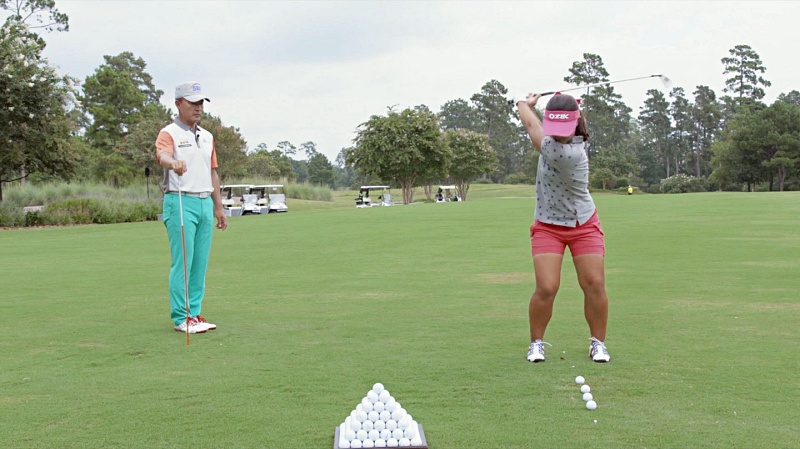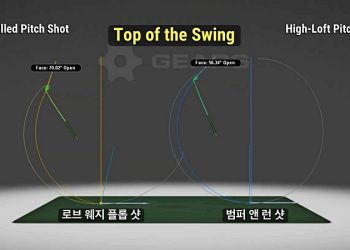골프에서 미들 아이언의 최대 비거리를 만들어내는 다운블로(downblow) 샷은 물리학적으로 로포인트(Low Point)와 밀접한 관련이 있다. 이를 런치 모니터의 로포인트 개념을 통해 알아보자.
로포인트란 스윙 궤도의 최저점을 의미하는데 보통 임팩트 지점을 기준으로 전후에 위치할 수 있다. 미들아이언 샷에서 최적의 로포인트는 임팩트 이후에 위치해야 한다. 그러면 미들 아이언의 가장 좋은 로포인트는 어느 정도 길이에서 만들어져야 할까? 답은 임팩트 지점 이후 3~5인치(10㎝ 전후)에서 발생하는 것이다.
드라이버 샷과는 다르게 미들아이언 샷은 네거티브 어택 앵글로 만들어진다. 물리학적으로 볼 때 이때가 에너지 전달이 가장 좋다. 로포인트가 임팩트 이후에 있으면 클럽 헤드가 아래쪽으로 이동하는 궤도로 볼을 타격한다. 이는 클럽헤드의 운동 에너지를 볼에 더 효율적으로 전달한다.

볼의 압축 관점에서 보면, 네거티브 어택 앵글은 볼을 클럽페이스에 더 강하게 압축시킨다. 이는 볼의 반발력을 증가시키고 볼의 초기 속도도 높인다. 또 아래로 내리치는 궤도는 볼에 더 많은 백스핀(역회전)을 만들게 된다. 적절한 역회전은 볼의 비행 안정성을 높이고 비거리를 증가시킨다.
네거티브 어택 앵글로 인해 가장 이상적인 볼의 런치 앵글도 발생된다. 이는 볼의 초기 탄도를 개선하여 최대 비거리가 나오게 한다.
로포인트가 임팩트 이후에 있으면 클럽이 잔디를 깔끔하게 통과한다. 이는 일관된 접촉을 가능케 하여 샷의 정확성도 좋게 한다.
위의 내용을 바탕으로 실전에서 로포인트를 만들기 위한 기본자세는 다음과 같다. 먼저 볼의 위치는 스탠스의 중앙보다 약간 뒤쪽에 둔다. 그리고 임팩트 시 체중을 앞발로 이동시킨다. 그립을 잡고 있는 양손은 볼보다 약간 앞서게 한다. 샤프트가 목표 방향 쪽으로 기울어진 상태에서 임팩트되는 것이 매우 중요하기 때문이다.
결론적으로 네거티브 어택 앵글로 일정하게 볼을 치면 스윙의 로포인트도 길게 만들게 되면서 미들아이언 샷의 비거리를 가장 멀리 보낼 수 있다.
☞ 전욱휴는…
서울대 졸업 후 미국에 유학, 1996년 PGA 클래스A 프로가 됐다. 이후 28년만인 2024년 전세계 골프계 최고 권위의 ‘PGA 마스터 프로페셔널’ 자격을 획득했다. SBS, MBC, JTBC, YTN 등의 골프 채널 진행자 및 해설자로 활약했고, 지금은 애틀랜타와 한국을 오가며 골프 레슨 및 골프 관련 비즈니스를 하고 있다. chungolf@gmail.com
[Dr.Eric Chun’s Golf Lesson] 38. The Divot for a Perfect Impact Swing!
The divot for a mid-iron shot should extend up to 10 centimeters (3-5 inches) after the ball is struck
In golf, achieving maximum distance with a mid-iron using a downblow shot is closely related to the concept of the Low Point from a physics perspective.
This can be explained using the Low Point concept measured by a launch monitor.
The Low Point refers to the lowest point in the swing path, which can occur either before or after the impact position. For mid-iron shots, the optimal Low Point should be located after impact. So, where exactly should the ideal Low Point for a mid-iron shot be positioned?
For mid-iron shots, the ideal Low Point occurs 3-5 inches (approximately 10 centimeters) after impact.
Unlike driver shots, mid-iron shots are executed with a negative angle of attack.
From a physics standpoint, this negative angle of attack enables the most efficient energy transfer during impact. When the Low Point is positioned after impact, the clubhead strikes the ball on a descending path. This allows the kinetic energy of the clubhead to be transferred more effectively to the ball.
Additionally, from the perspective of ball compression, a negative angle of attack compresses the ball more firmly against the clubface. This increased compression enhances the ball’s rebound force and initial velocity. Furthermore, striking downward on this trajectory generates more backspin on the ball. Proper backspin improves flight stability and increases carry distance.
The negative angle of attack also produces an optimal launch angle for the ball, improving its initial trajectory and enabling maximum distance.
When the Low Point is positioned after impact, the club passes cleanly through the turf. This ensures consistent contact and improves shot accuracy.
Based on these principles, creating an ideal Low Point in practice starts with proper ball positioning. Place the ball slightly behind the center of your stance. During impact, shift your weight onto your lead foot. Ensure that your hands are slightly ahead of the ball when gripping the club. It is crucial that the shaft leans toward the target at impact.
In conclusion, by consistently striking with a negative angle of attack, golfers can extend their swing’s Low Point and achieve maximum distance with mid-iron shots.




![[전욱휴의 골프 레슨] 38. 미들아이언 스윙 때 디봇](https://www.atlantajoongang.com/wp-content/uploads/2024/12/ZKakaoTalk_20241217_084132102_01-750x763.jpg)

















![[전욱휴의 골프 레슨] 46. 배치기(얼리 익스텐션)](https://www.atlantajoongang.com/wp-content/uploads/2025/03/photoKakaoTalk_20250306_073237889_01-350x250.jpg?v=1741361116)
![[전욱휴의 골프 레슨] 45. 임성재 '행온페이드' 샷](https://www.atlantajoongang.com/wp-content/uploads/2025/02/collage1-350x250.jpg)
![[전욱휴의 골프레슨] 44. 일관된 샷을 원한다면](https://www.atlantajoongang.com/wp-content/uploads/2025/02/QKakaoTalk_20250212_065748485-350x250.jpg)

![[전욱휴 골프 레슨] 42. 오른쪽 팔꿈치 역할](https://www.atlantajoongang.com/wp-content/uploads/2025/01/qQ1KakaoTalk_20250130_072058648-350x250.jpg)
![[전욱휴의 골프 레슨] 41. 매킬로이 파워 스윙](https://www.atlantajoongang.com/wp-content/uploads/2025/01/qQ1KakaoTalk_20250122_123635940-350x250.jpg)
